Durbachite
Category: Plutonic
Type A fine- to coarse-grained melanocratic variety of syenite, which is named „Čertovo břemeno“ type at the Sedlec – Prčice locality. Apart from the durbachite, quartz melasyenite and melagranite also belong to the „durbachite rock serie“. The „Čertovo břemeno“ rock type was for the first time introduced by Zelenka (1925) and the variability of “durbachite rock series” was later described by Orlov (1933) and Zikmund (1974).
Commons Durbachite is fine- to coarse-grained melanocratic syenite consisting of large flakes of biotite with hornblende and orthoclase megacrysts in a groundmass composed of oligoclase and minor quartz.
Name origin Durbachite was described for the first time by Sauer (1892) and named after the type locality in Schwarzwald – Durbach close to Offenburg in the southern part of Germany.
Locality Sedlec – Prčice, Středočeský pluton, Czech republic.
GPS:
Major minerals Alkali feldspar (Or65,5-79,1), Ca-Na plagioclase (An34-36), biotite, actinolite, diopside, quartz – interstitial
Accessory minerals Apatite, zircon, monazite, rutile, allanite, titanite, rarely sulphides (pyrrhotite, pentlandite, pyrite).
Classification The syenite field is defined by the modal composition of quartz (Q 0 – 5 %) and the plagioclase ratio P/(P + A) between 10 and 35 in the upper part (APQ) of QAPF diagram for plutonic rocks (Streckeisen, 1976).
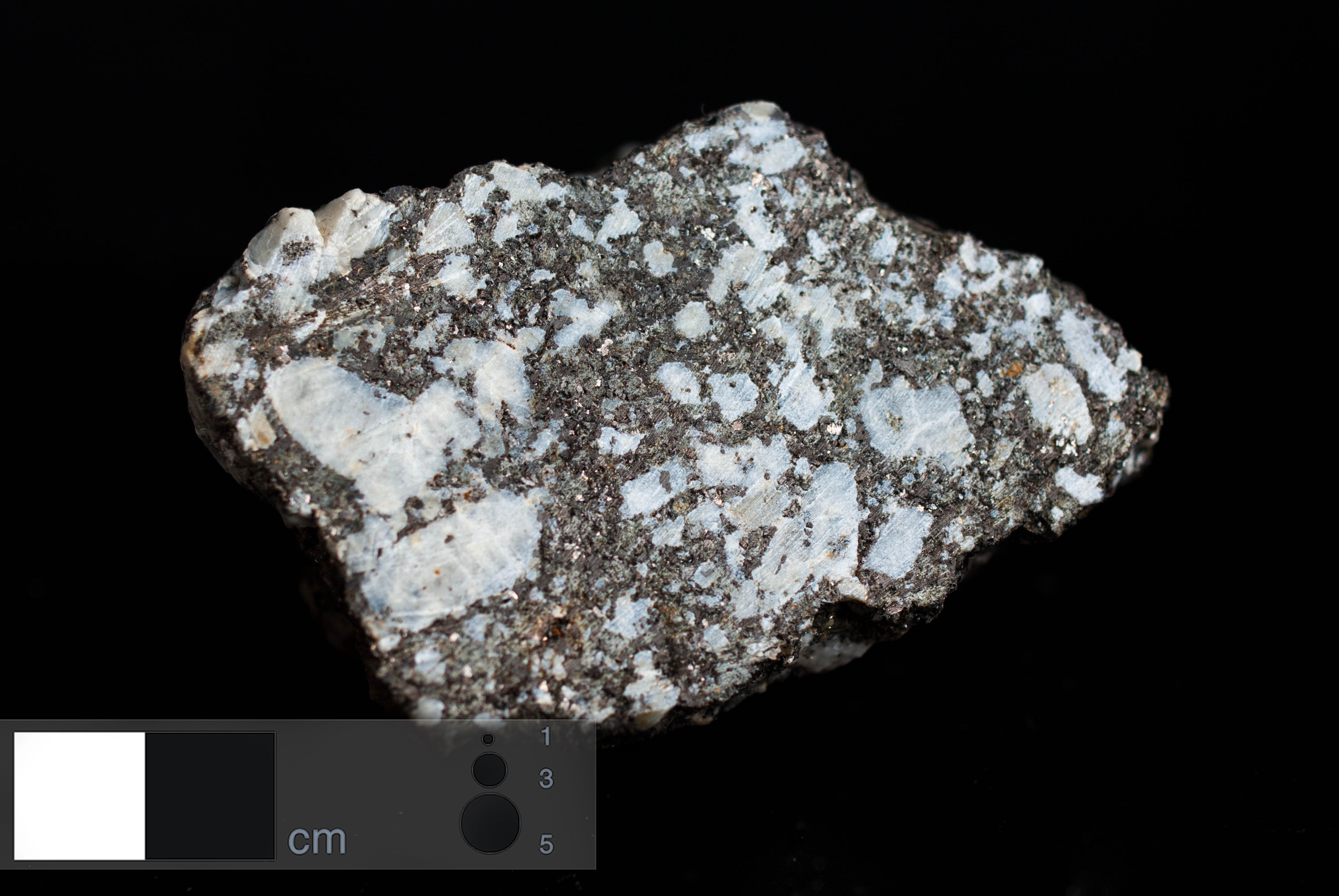
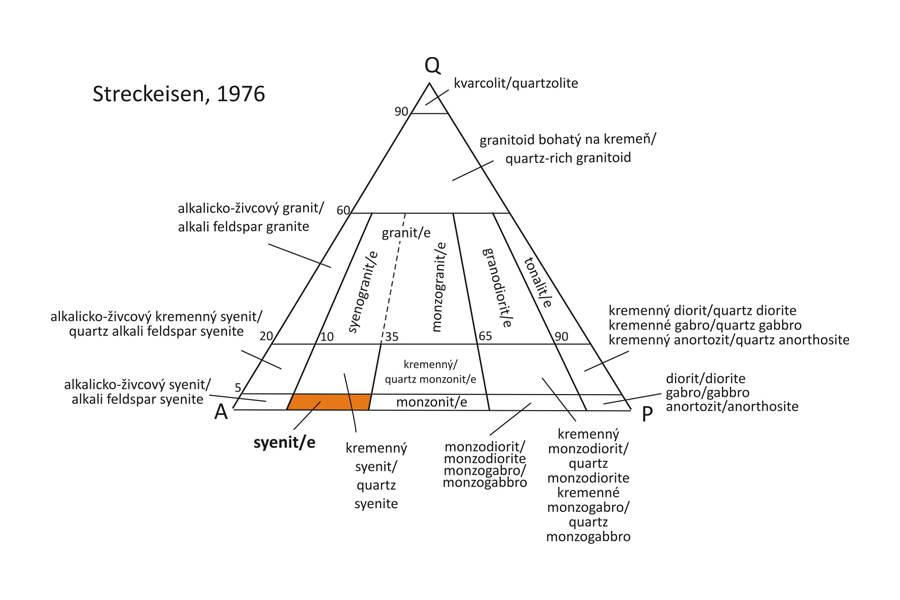
Colour Black, black-brown with light white-grey alkali feldspar porfyroclasts.
Structure Massive, faneritic.
Granularity Medium- (1 – 3 mm) to coarse grained (> 1 cm) rock.
Texture Phaneritic, hypidiomorphic, localy porphyric.
Alterations Feldspars are moderately sericitized.
Petrographic characteristics Medium- to coarse-grained syenite with alkali feldspar phenocrysts in dark groundmass. Alkali feldspar porphyroclast are often twinned according to the „Carlsbad law“. Dark minerals in groundmass correspond to biotite, actinolite and rarely diopside - a relict in hornblende phenocrysts. Finely grained quartz and oligoclase occur also in intergranular spaces in the groundmass.
Usage Decorative stone and building material.
Literature Breiter, K., 2008: Durbachity Třebíčského masivu ve vrtu Požďátkz V-5 – genetická implikace. Geoscience Research Reports for 2007, Czech Geological Survey, Prague, 143-147. Foley, S.F., Venturelli, G., Green, D.H. & Toscani, L., 1987: The ultrapotassic rocks: Characteristics, classification, and constraints for petrogenetic models. Earth Sci. Rev., 24, 81-134. Holub, F. V., 1997: Ultrapotassic plutonic rocks of the durbachite series in the Bohemian Massif: Petrology, geochemistry and petrogenetic interpretation. Sborní geologických věd, Ložisková geologie, mineralogie. ČGÚ Praha, 31, 5-26. Mitchell, R. H. & Bergman, S. C., 1991: Petrology of Lamproites. New York: Plenum Press. 1-447 pp. Orlov, A., 1933: Contribution l´étude pétrographique du massif „granitique“ de la Boheme Centrale (région de Říčany Benešov-Milevsko-Písek), in Czech with French summary. Věstník Státního geologického ústavu Československé republiky, 9, 135-145. Sauer, A., 1892: Der Granitit von Durbach im nördlichen Schwarzwalde und seine Grenzfacies von Glimmersyenit (Durbachit). Mittheilungen der Grossherzoglich Badischen Geologischen Landesanstalt, 2, 231-276. Zelenka, L., 1925: Poznámky ku geologickým poměrům listu Sedlčany – Mladá Vožice. Státní geologický ústav Československé republiky, 1, 105 – 115. Zikmund, J., 1974: Uranová mineralizace v centrální části středočeského plutonu. Nepublikovaná CSc. práca, Karlova Univerzita, Praha, 1-73.
Photomicrographs
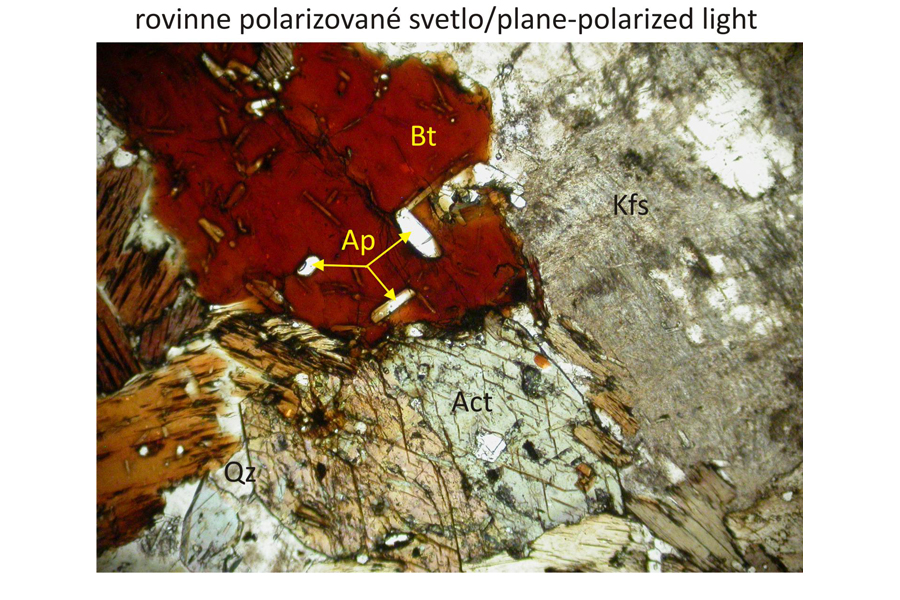
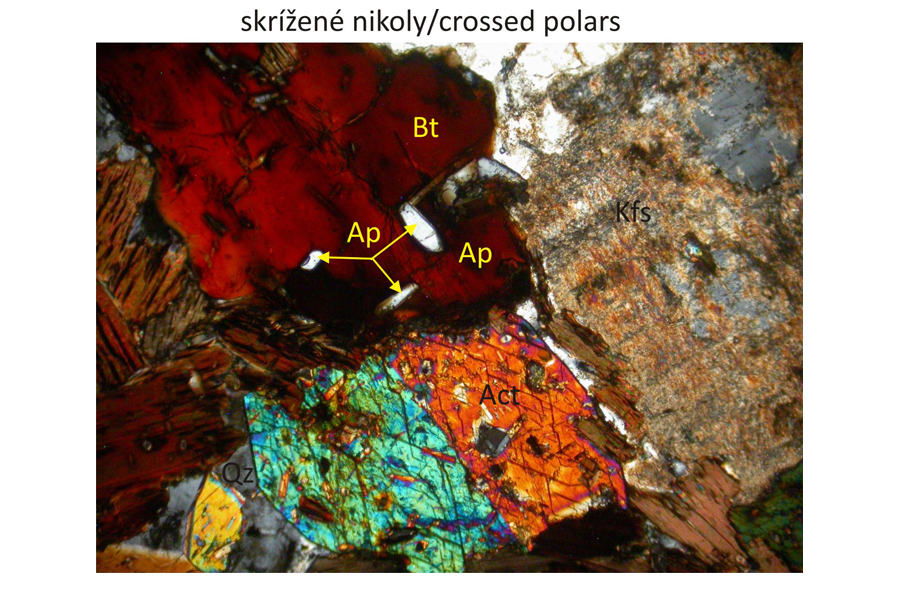
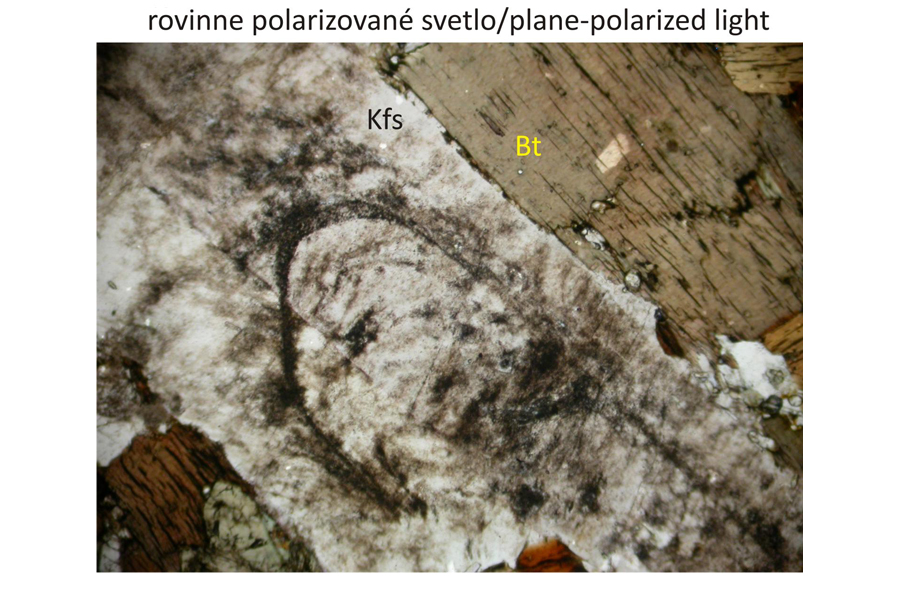
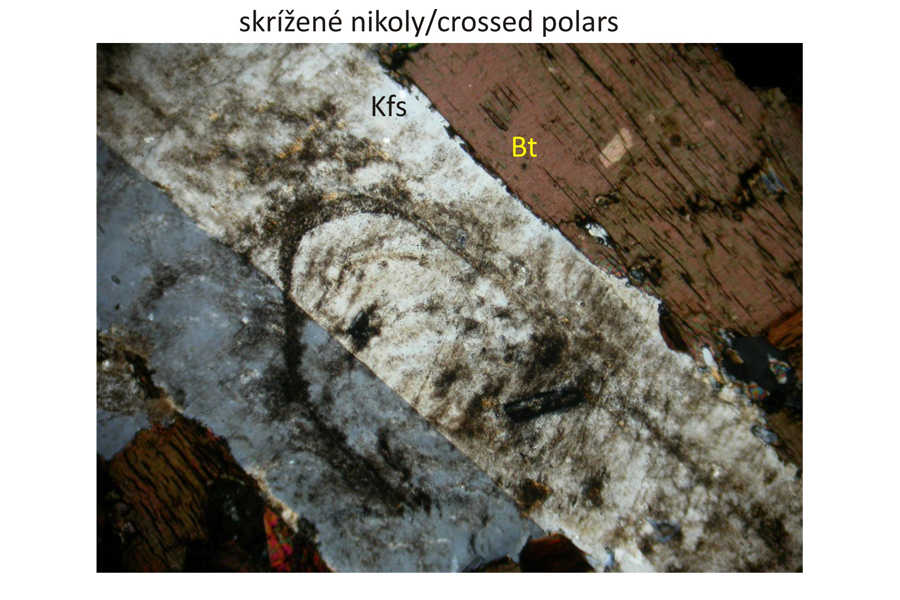
Sericitized phenocryst of potassium feldspar – Kfs in groundmass composed of biotite – Bt, actinolite – Ac, and quartz – Qz. Biotite often encloses accessory apatite – Ap (upper photomicrographs). A large phenocryst of potassium feldspar – Kfs twinned according to the Carlsbad law alongside biotite – Bt (lower photomicrographs). Width of the photomicrographs is 2.2 mm.
Normative composition
Durbachite displays the normative composition anomalous for alkaline rocks, because it contains neither modal nor normative foids and/or alkalic pyroxenes/amphiboles. Despite this, durbachites are ultrapotassic rocks what is expressed by an increased content of the normative orthoclase – or. A high Mg content is projected in the normative hypersthene – hy and a supersaturation in Si in the normative quartz – q.
Normative minerals
SiO2
TiO2
ZrO2
Al2O3
Fe2O3
FeO
MnO
MgO
CaO
Na2O
K2O
P2O5
F
S
CO2
Total
Molar proportion of normative mineral
Molecular mass of normative mineral
Weight % of normative mineral
Oxide
(wt. %)
58.43
1.06
13.76
6.58
0.09
6.29
3.71
1.7
7.33
1.01
99.96
Molecular
weight
60.08
79.88
101.96
159.69
70.94
40.31
56.08
61.98
94.2
94.2
Molecular
proportion
0.9725
0.0133
0.1350
0.0412
0.0013
0.1560
0.0662
0.0274
0.0778
0.0778
ap
0.0237
0.0071
0.0071
328.68
2.34
il
0.0013
0.0013
0.0013
151.75
0.19
tn
0.0120
0.0120
0.0120
0.0120
196.07
2.35
or
0.4669
0.0778
0.0778
0.0778
556.67
43.32
ab
0.1646
0.0274
0.0274
0.0274
524.46
14.38
an
0.0594
0.0297
0.0297
0.0297
278.21
8.27
hm
0.0412
0.0412
159.69
6.58
zvyšky
0.0000
0.1560
di
0.0015
0.0000
0.0007
0.0007
216.56
0.16
hy
0.1553
0.0000
0.1663
0.1663
100.39
15.59
q
0.1129
0.1129
60.08
6.78
D: -0.1129
Mg/(Mg+Fe2+): 1.000
Total of normative wt. % 99.96
Comment A lack of Fe2+ in the chemical analysis caused the allocation of whole molar proportion of Ti in titanite – tn and not in ilmenite il. A small molar proportion of Fe2+ is a result of the addition of molar proportion of Mn, which is used in the normative ilmenite – il. The whole molar proportion of Fe3+ occurs in the normative hematite – hm. Small molar proportion of Ca remaining after the creation of normative anorthite and titanite remained for the creation of normative diopside – di. Also the content of normative apatite – ap is relatively high.
Chemical composition
Durbachite is very specific, even anomaly plutonic magmatic rock. It is a metaluminous, alkalic, ultrapotassic rock with the K2O content > 3 wt. %, the K2O/Na2O ratio > 2 and the MgO content > 3 wt. % (Foley et al., 1987). According to Mitchell and Bergman (1991), ultrapotassic rocks exhibit the molar K/Na ratio > 3. Typical melanocratic durbachites from the Sedlec – Prčice locality have K/Na ratios ranging between 3.76 and 5.26, and the medium-dark varieties between 3.92 and 4.82. Ultrapotassic rocks of the World are prevailingly volcanic or hypoabbysal, whereas their plutonic equivalents are very rare. Durbachite is significantly enriched in MgO compared to common syenite, and it differs from the syenite also in terms of increased Al2O3 and CaO contents. Durbachites are also significantly enriched in LREE, showing a negative slope of the normalized distribution of the rare elements and the Eu/Eu* ratio = 0.8-0.9. Taktiež sú významne obohatené o LREE s negatívnym sklonom normalizovanej krivky vzácnych zemín a vyznačujú sa Eu anomáliou Eu/Eu* = 0,8-0,9. Durbachite originate from a mantle-derived magma modified by mingling with a crust-derived leucogranite magma in various ratios, and/or by a fractionation. It is supposed that the lithospheric mantle must have been moderately depleted prior to the melting by separation of the basaltic component and subsequently metasomatically enriched (Holub 1997).
-
SiO2
58.43TiO2
1.06Al2O3
13.76Fe2O3
6.58MnO
0.09MgO
6.29CaO
3.71Na2O
1.70K2O
7.33P2O5
1.01Total
99.96Mg(Mg/Fe2+)
0.65A/CNK
0.79A/NK
1.28
-
SiO2
52.70TiO2
1.27Al2O3
13.53Fe2O3
0.98FeO
6.02MnO
0.11MgO
8.51CaO
4.92Na2O
1.63K2O
6.67H2O+
1.20Total
98.79Mg(Mg/Fe2+)
0.72A/CNK
0.72A/NK
1.37
-
SiO2
53.77TiO2
1.20Al2O3
13.69Fe2O3
7.47MnO
0.10MgO
8.81CaO
4.58Na2O
1.54K2O
7.17P2O5
1.17Total
99.50Mg(Mg/Fe2+)
0.70A/CNK
0.74A/NK
1.33


